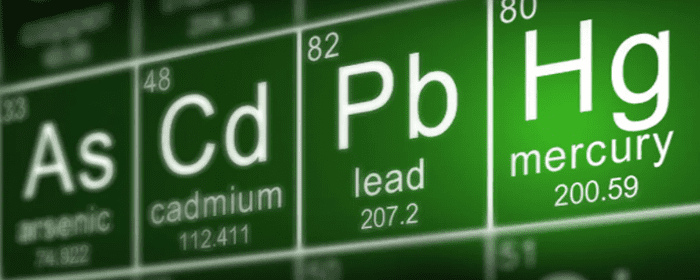Heavy metals are found naturally in the earth and used widely across many industries. The body also naturally contains certain heavy metals, such as iron, zinc, and copper, which help to promote optimal functioning. When your soft tissues absorb a heavy metal in excess, it leads to a condition known as heavy metal poisoning.
The most common heavy metals that cause toxicity when absorbed by the body include:
- lead
- mercury
- arsenic
- cadmium
Sources of exposure for these metals could include medicine, pollution, food, lead-based paint, and working in industrial settings.
Heavy metal poisoning is considered rare in the U.S., but it can still occur. The condition develops when someone is exposed to high levels of metal over a prolonged period of time.
Symptoms
Symptoms of heavy metal poisoning can include nausea, diarrhea, vomiting, shortness of breath, and tingling in the extremities. Weakness and chills may also occur.
There are also symptoms specific to each type of metal. For example, mercury poisoning may cause poor coordination, difficulty walking, nerve damage in the hands and face, and muscle weakness. Lead poisoning is characterized by sleep problems, aggression, constipation, irritability, anemia, headaches, and memory loss. In arsenic poisoning, red or swollen skin may develop, along with muscle cramps, irregular heartbeat, and lesions on the skin. Finally, cadmium poisoning is marked by difficulty breathing, fever, and muscle pain.
Causes
Each specific metal type has unique circumstances leading to exposure as well. For instance, lead poisoning can occur after living in a home with lead paint, working at a firing range, using kohl cosmetics, or working in certain types of industrial construction. A person could be exposed to mercury in an environment that manufacturers mirrors, x-ray machines, or other products containing mercury. Eating contaminated fish can also lead to mercury poisoning, as can mining activities. Industrial work and cigarette smoke can lead to cadmium poisoning. Arsenic poisoning may occur after ingesting certain chemicals, such as insecticides, or living in an area with high levels of arsenic in the natural environment.
Diagnosis
Heavy metal poisoning can be diagnosed through a blood test known as a heavy metals panel. If you have symptoms of poisoning present but only low levels of heavy metal are detected, further testing may be performed. For instance, medical professionals could use hair, fingernail, or urine analysis, as well as X-rays and function studies of the kidney and liver.
You can also do a home comprehensive test to determine toxin and detoxification markers. The tests also include deficiencies and insufficiencies to help address the root cause of symptoms you may be experiencing. Learn more.
Treatment
Eliminating exposure to heavy metal is the first step in treating the condition. In mild cases, this may be sufficient for alleviating symptoms.
There are detoxification products available to also help address. There are 10 and 28-day programs to help facilitate the removal of undesirable compounds in the body.
In more severe cases, chelation therapy may be prescribed. In this treatment, the patient takes medication to bind the heavy metals in your body, which will then exit the body as waste. Chelation therapy may encompass oral pills or intravenous therapy.
For more health awareness blogs, please visit www.stemedix.com/blog


 St. Petersburg, Florida
St. Petersburg, Florida
